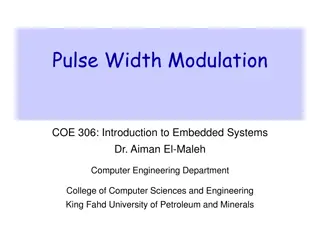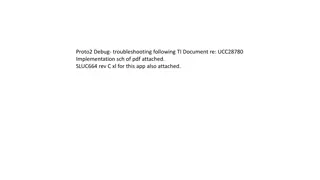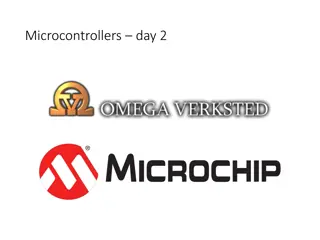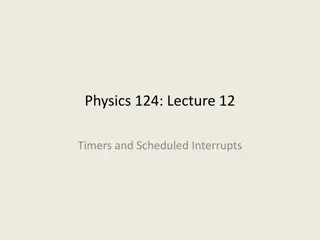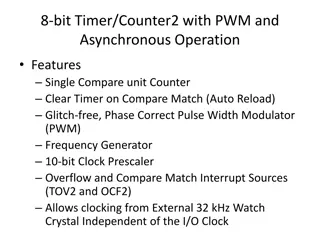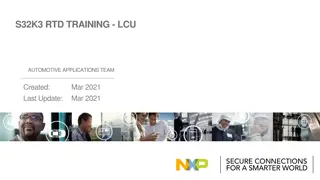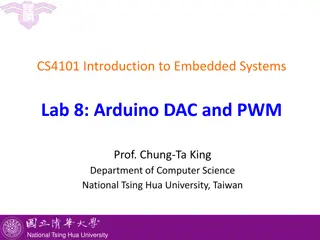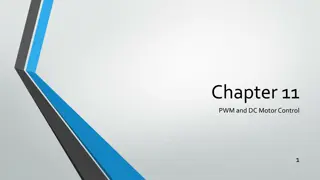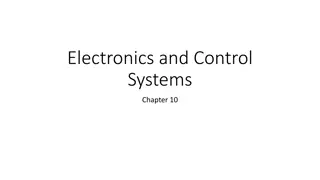Controlling DC Motor using PictoBlox
Learn to control a DC motor using PictoBlox programming by setting the direction and speed of the motor, using a potentiometer and slide switch. Understand what a DC motor is, how it functions, and how to control its speed. Explore circuit diagrams, motor controlling blocks, and the process of contr
1 views • 20 slides
Understanding Pulse Width Modulation in Embedded Systems
Pulse Width Modulation (PWM) is a technique that uses a rectangular pulse wave to modulate the pulse width, controlling power delivery to devices effectively. It involves altering the average value of a waveform by switching it on and off within a specified period. PWM has various applications, from
0 views • 26 slides
Troubleshooting Guide for UCC28780 Implementation - Proto2 Debug
This troubleshooting guide provides detailed steps for diagnosing issues related to the Proto2 system using the UCC28780 implementation. It includes measurements, waveforms, and observations to help identify and address problems such as rapid Vdd discharge and lack of step transitions on Vhvg. The g
0 views • 7 slides
Understanding Microcontroller Interrupts and Applications
Explore the fundamental concepts of interrupts, PWM, timer/counters, and ADC in microcontrollers. Learn how to use interrupts for tasks like LED blinking, control LED brightness with PWM, and read voltage using ADC. Get insights on interrupt routines, enabling interrupts through registers, and tips
0 views • 32 slides
Understanding Timers and Scheduled Interrupts in Physics 124
The lecture covers timer basics for Arduino Uno/Nano, discussing available timers, prescaler options, PWM frequencies, and implementation details. It explains prescaling and frequency concepts, wrap times for Timer0, Timer1, and Timer2, and the importance of timed interrupts for creating a schedule
0 views • 21 slides
8-bit Timer/Counter2 with PWM and Asynchronous Operation
The 8-bit Timer/Counter2 with PWM and Asynchronous Operation features single compare unit, glitch-free operation, phase-correct PWM, frequency generator, clock prescaler, interrupt sources, and external clocking options. It includes registers for control, counter, output compare, asynchronous status
0 views • 14 slides
S32K3 Real-Time Development Training Overview
Explore the S32K3 Real-Time Development (RTD) training for Logic Control Unit (LCU) in automotive applications. Learn about LCU configuration, main API functions, example codes, Look-Up Table (LUT) setup, and tips for optimal usage. Discover how LCU interacts with combinatorial logic, latches, and a
0 views • 22 slides
Introduction to Arduino DAC and PWM in Embedded Systems Lab
Explore the practical application of Arduino's digital-to-analog converter (DAC) and pulse width modulation (PWM) techniques through projects involving RGB LED modules, analog joysticks, and stepper motors. Learn to control RGB LED colors, read analog joystick input values, and operate stepper motor
0 views • 10 slides
DC Motor Control Techniques and Configurations
This chapter delves into various aspects of PWM and DC motor control, exploring characteristics of selected DC motors, rotation mechanisms, H-bridge configurations for motor direction control, logic configurations for motor operation, bidirectional motor control using an L298 chip, pulse width modul
0 views • 27 slides
Electronics and Control Systems Chapter 10
The chapter delves into PWM systems, discussing counter and compare values, PWM signal outputs, various PWM signals with different duty cycles and frequencies, the impact of system configuration on flow rate in a centrifugal pump, different communication topologies in sprayers, and lightbar-assisted
0 views • 29 slides

